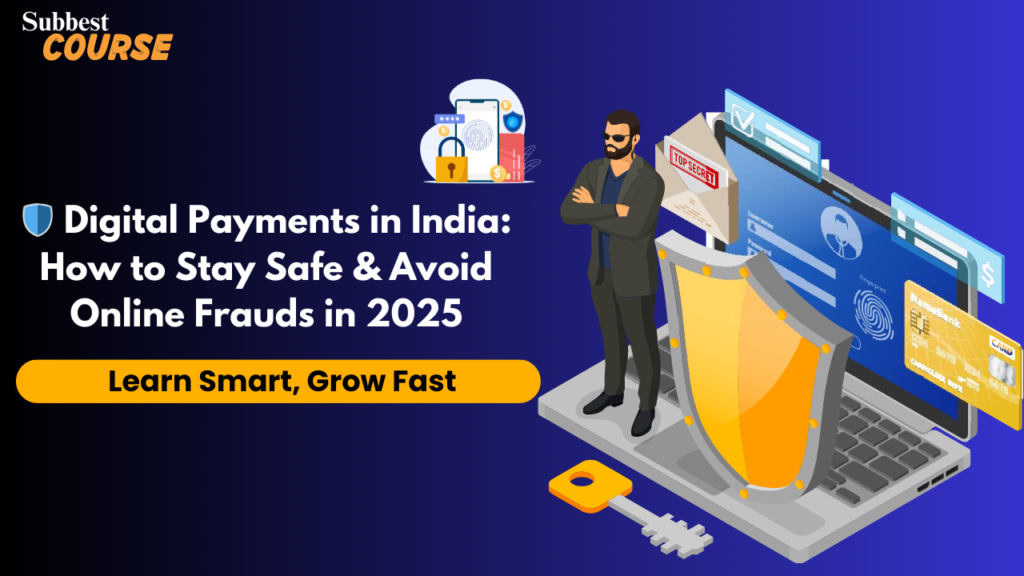Introduction
India is rapidly becoming a cashless economy. Thanks to platforms like UPI, Paytm, PhonePe, Google Pay, and internet banking, making payments has become easier than ever. But with this digital growth comes an increase in cyber frauds, scams, and digital theft.
According to a report by RBI, India saw over 13,000 digital payment fraud cases in 2024 alone. That’s a scary number — but the good news is: you can protect yourself with a few smart precautions.
In this guide, we’ll explore the most common types of digital payment frauds and give you 7 proven strategies to stay 100% secure online.

Common Types of Digital Payment Frauds
Understanding how frauds happen is the first step to prevention. Here are the most common methods used by cybercriminals in India:
- Phishing Attacks: Fake emails or SMS messages tricking users to enter their passwords, card info, or OTPs.
- Fake QR Codes: Scammers send a QR code and ask you to scan it to “receive” money — but it actually sends your money.
- Fraudulent Customer Care Numbers: Google a bank number, call a fake one, and the fraudster gets your sensitive info.
- Remote Access Apps: Scammers ask you to install apps like AnyDesk or TeamViewer and take control of your phone.
- Fake Loan or Cashback Offers: Messages claiming you’ve received a reward or refund — click, and your data is stolen.
7 Digital Payment Safety Tips You Must Follow
✅ 1. Never Share Sensitive Info (PIN, OTP, CVV)
This is the #1 rule of online payment safety. No real bank or payment app will ever ask for your:
- UPI PIN
- OTP
- Debit/Credit Card CVV
- Net Banking Password
If someone asks — it’s a fraud. Period.
✅ 2. Always Use Trusted Apps & Official Websites
- Download apps only from Google Play Store or Apple App Store
- Use apps with millions of downloads and verified developers
- Avoid clicking payment links from unknown numbers or emails
Use verified websites with “https” before the URL.
✅ 3. Check QR Codes Carefully Before Scanning
- Real QR codes are only used for paying — not for receiving money.
- Fraudsters will say: “Scan this QR code, I’m sending you ₹500” — that’s a scam!
Never scan a QR code unless you’re making a purchase from a trusted vendor.
✅ 4. Turn on Two-Factor Authentication (2FA)
- Enable 2FA for banking, payment apps, and email.
- Use Google Authenticator or SMS OTP to secure your login.
Even if someone steals your password, they won’t get in without the second step.
✅ 5. Avoid Using Public Wi-Fi for Transactions
- Free Wi-Fi in malls, cafes, or stations may be unsafe.
- Hackers can steal your data while you’re connected.
Use mobile data or a VPN if you must access banking apps on the go.
✅ 6. Monitor Your Account Regularly
- Check your transaction history weekly.
- Immediately report suspicious activity to your bank.
Even small ₹1 transactions could be tests by fraudsters before bigger theft.
✅ 7. Report Fraud Immediately
If you are a victim of fraud, don’t panic — act fast:
- 📞 Call 1930 – Cyber Crime Helpline (24×7)
- 🌐 File a complaint at: www.cybercrime.gov.in
- 🏦 Inform your bank and block your cards immediately
Fast action can help you recover your money faster.
Bonus Tips for Safe Digital Transactions
- ✅ Use strong, unique passwords for payment apps.
- ✅ Don’t save card details on shopping sites.
- ✅ Don’t share screenshots of payments on social media.
- ✅ Educate your family, especially senior citizens and kids.
📊 Digital Payments: Growth vs. Risk (2025)
| Year | UPI Transactions (in Billion ₹) | Fraud Cases Reported |
|---|---|---|
| 2022 | ₹84 Billion | 9,000+ |
| 2023 | ₹112 Billion | 11,200+ |
| 2024 | ₹135 Billion | 13,000+ |
Conclusion
Digital payments make our lives easier, but only when done securely. With fraud cases increasing in India every year, staying alert and informed is your biggest shield.
Keep these safety tips in mind and educate your friends and family too. Remember — one smart decision can save you lakhs.